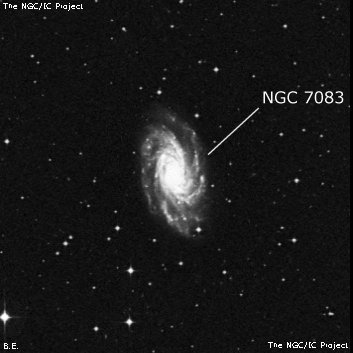
James Dunlop probably discovered NGC 7083 = D 263? = h3870 on 28 Aug 1826 and recorded "a small faint round nebula, 20 arcseconds diameter, a little brighter in the middle, following a group of pretty bright stars." His position is ~20' west of ESO 107-036 = PGC 67023. John Herschel found this galaxy on 22 Jun 1835 and logged "F; L; R of lE; vgpmbM; 60"; resolvable; with long attention it appears mottled. Perhaps Dunlop 263, with 3 minute correction in RA." On a later sweep he noted "pB; pL; R; gbM; 60"."
NGC 7083 is one of the brightest members of the Pavo-Indus Cloud along with NGCs 7213, 7205, 7049 and 7144.
600/800mm - 30" (10/14/15 - OzSky): at 303x; very bright, large, oval nearly 2:1 N-S, 3.0'x1.7', strongly and sharply concentrated with an intense, slightly elongated core that gradually brightens to the center. There was a strong hint of a spiral arm along the east side and another extending north on the west side, though they were not cleanly resolved from the general glow. The halo is a little irregular in surface brightness. A mag 14 star is just off the south end, 1.8' SSW of center. NGC 7096 lies 37' E.
Notes by Steve Gottlieb